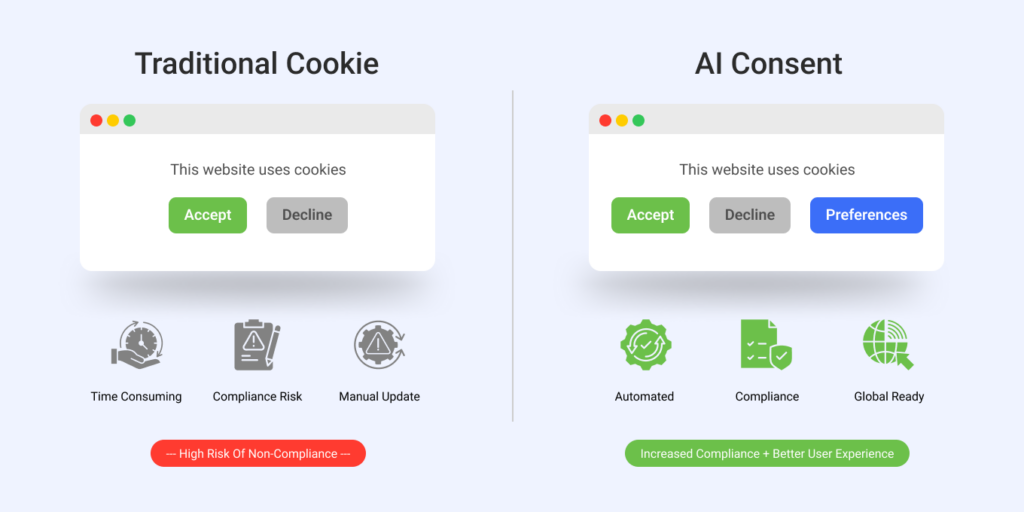It’s 2025, and AI has permeated nearly every aspect of our digital lives—from personalised content and predictive analytics to automated customer interactions. As artificial intelligence reshapes how user data is tracked, analysed, and personalised, GDPR AI cookie consent has become far more than a legal checkbox—it’s a strategic necessity. With regulators tightening their grip under evolving data privacy laws in Europe, website owners must navigate the delicate balance between personalisation and compliance like never before.
So, what happens when AI meets cookies? How do you align personalisation tools with GDPR cookie consent requirements while preserving a seamless user experience? As AI-driven tracking becomes more advanced, maintaining transparency and user control is no longer optional—it’s expected, enforced, and essential to building digital trust.
This guide will help you decode GDPR AI cookie consent for 2025, offering actionable strategies, a comprehensive website GDPR compliance checklist, and a clear breakdown of what you must do to remain compliant in an AI-driven world.
The General Data Protection Regulation (GDPR) remains the primary legislation for personal data protection with AI in Europe. Combined with the ePrivacy Directive, GDPR governs how cookies and tracking technologies are used, especially when tied to AI systems.
In 2025, GDPR and AI regulations are more stringent, emphasising transparency, consent, and user control over personal data. Third-party cookies under GDPR rules are also under deeper regulatory examination due to their intrusive nature.
To meet GDPR cookie consent requirements, website owners must ensure:
Legal obligations stem from Article 6 and Article 7 of the GDPR, with users having the right to withdraw consent at any time. This becomes more complex when cookies are paired with AI-powered tools, requiring a dual compliance layer.
Understanding how AI affects cookie consent is crucial in 2025. While cookies deal with tracking user activity, AI can use that data for automated decision-making or user profiling. This activates stricter obligations under Article 22 of the GDPR, which governs GDPR compliance for AI-driven websites.
To better understand the distinction between cookie consent and AI consent, here’s a detailed comparison of their key aspects:
| Aspect | Cookie Consent Management | AI Cookie Consent Management | |
|---|---|---|---|
| Scope | Tracks user activity via cookies | Processes personal data via algorithms | |
| Legal Basis | Article 6 + ePrivacy Directive | Article 22 of GDPR | |
| User Rights | Right to withdraw, refuse | Right to explanation, object, and human intervention | |
| Risk Level | Moderate | High | |
| Transparency | Disclose cookie purpose | Explain the algorithm logic and outcomes | |
| Use Cases | Ad targeting, analytics | Profiling, credit scoring, and dynamic pricing | |
| Compliance Tool | Automated cookie banners | AI-based scoring tools and explainability reports |
If you’re using AI to process data collected through cookies, both cookie consent compliance (2025) and AI-specific permissions are required.

AI brings efficiency and real-time personalisation to websites, but it also introduces significant compliance risks. Automated tools that personalise content or offers must still adhere to GDPR AI cookie consent rules, ensuring users are aware and in control.
The AI impact on GDPR compliance is especially visible in:
For GDPR compliance for AI-driven websites, AI implementations must adhere to GDPR’s core principles:
Transparency is non-negotiable—users have the right to understand how and why they’re being profiled or targeted.
In 2025, both the Information Commissioner’s Office (ICO) and the European Data Protection Board (EDPB) have emphasised stricter regulation around AI and cookies. Their latest guidance outlines:
Regulators also reinforced that “consent or pay” models, while not outright illegal, must offer clear alternatives and transparent data handling.
Your cookie consent banner for GDPR should empower, not pressure, users. Effective banners:
AI can support dynamic banner customisation, but the GDPR AI cookie consent framework must be upheld throughout.
The “Consent or Pay” model has emerged as a way for websites to provide users with a choice: either accept cookies and consent to data collection or pay for an ad-free, tracked-free experience. This practice ties access to services or content directly to the user’s decision about data collection, often offering users a paid alternative if they refuse tracking.
This model is controversial. While technically allowed under specific circumstances, GDPR and AI regulations in 2025 require that:
Use caution and consult legal guidance if exploring this model.
A Consent Management Platform (CMP) is essential for streamlining cookie consent compliance in 2025. Choose a platform that:
Seers AI is a leading CMP offering real-time, regulation-ready workflows across GDPR, CCPA, LGPD, and Google Consent Mode.
Follow this GDPR compliance checklist to stay secure in 2025:
Step 1: Conduct a Cookie and AI Tracker Audit
Step 2: Implement a Smart CMP
Step 3: Train Your Teams
GDPR AI cookie consent is more than a legal requirement—it’s a reflection of your brand’s commitment to transparency, integrity, and respect for user privacy. As AI continues to transform how websites interact with visitors, your compliance strategy must evolve just as intelligently.
By adopting a smart Consent Management Platform like Seers AI and implementing a clear GDPR compliance checklist, you position your business to meet regulatory demands, avoid costly penalties, and foster long-term user trust.
Don’t wait for a GDPR fine. Start using Seers AI—the all-in-one GDPR AI cookie consent solution—and make your website secure, compliant, and future-ready today.
To stay compliant with GDPR, websites must ask users for their consent before using non-essential cookies, like those for analytics or ads. Users should always have the option to accept or decline, and it should be easy to change their minds at any time.
AI tools use cookies to gather and analyse personal data, often for things like ads or recommendations. Because AI can make decisions about users, special attention needs to be paid to it under GDPR. Websites need to get consent for both the cookies and the AI-driven processing of that data.
Not complying with GDPR AI cookie consent can lead to heavy fines and legal trouble. On top of that, it can hurt your brand’s reputation and cause users to lose trust in your site. Making sure you have proper consent mechanisms in place is vital to avoid these issues.
The “Consent or Pay” model is a bit tricky. While it’s not banned, GDPR requires that users have a real choice, meaning they can’t be forced into paying just to get access. Both options need to be fair and transparent to avoid breaking any rules.
Your cookie consent banner should clearly explain what cookies are being used and why. Give users the choice to accept or reject cookies without any tricks, like pre-checked boxes. Make sure they can easily change their preferences later, and you’re all set for compliance.
 Rimsha Zafar
Rimsha ZafarRimsha is a Senior Content Writer at Seers AI with over 5 years of experience in advanced technologies and AI-driven tools. Her expertise as a research analyst shapes clear, thoughtful insights into responsible data use, trust, and future-facing technologies.


United Kingdom
24 Holborn Viaduct
London, EC1A 2BN
Get our monthly newsletter with insightful blogs and industry news
By clicking “Subcribe” I agree Terms and Conditions

Seers Group © 2025 All Rights Reserved
Terms of use | Privacy policy | Cookie Policy | Sitemap | Do Not Sell or Share My Personal Information.